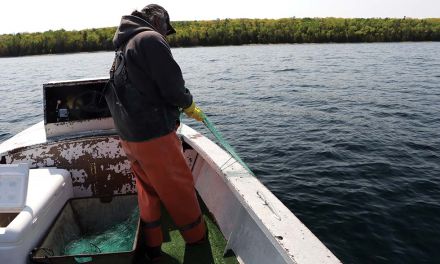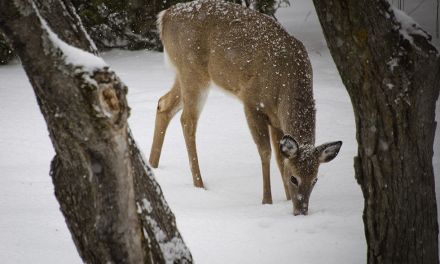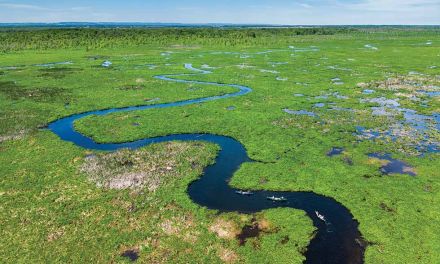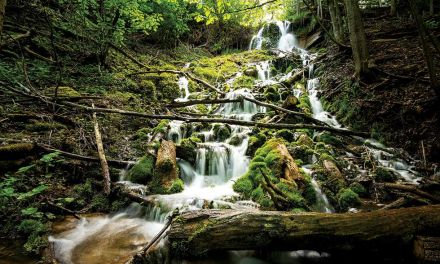Joe pye weed (eupatorium maculatum).
REVIVING LANDSCAPES
by Thorsten Arnold, photography by Clay Dolan
The Power of Indigenous Plants in Gardening and Landscaping
In some Native languages the term for plants is deeply evocative, translating to “those who take care of us.” This profound perspective is highlighted by Robin Wall Kimmerer in “Braiding Sweetgrass”, emphasizing the reciprocal relationship between humans and the plant world.
Like many of us, Thornbury residents Ann Joyner and Arnis Pukitis tried to make the best of the COVID era by turning a passion project into reality. In 2021, the couple restored their entire property to native forests, shrubs and herbaceous plants. Their vision was to create a layered, all-season garden that is ecological, gorgeous and inspiring. The garden mimics natural shapes and blurs the line between natural forest and garden beds with dozens of native plant species. The composition of colourful flowers not only looks beautiful, it also provides a ‘supermarket’ for local populations of birds, mammals and insects. The couple shared their passion by hosting garden tours: this new way of gardening for beauty and nature is generating lots of interest. Ann: “We welcome friends and neighbours to take a walk among the plants with us and be inspired to go native!” Now that the plants have taken firm root, the couple is impressed by how easy they are to maintain: plants are adapted to our climate and do well without watering or much attention.
And the couple is not alone. In Owen Sound, artist Liz Zetlin transformed her front yard. From her porch, she now looks onto a colourful mix of native plants, interspersed with a couple of her exotic favourites. “I’ve been learning about native plants’ importance in our ecosystems, and I’ve completely changed my attitude. I realized I was gardening for my own sense of beauty— peonies, Japanese maples, and irises—but I wasn’t planting for pollinators, so many of whom are endangered.” Today, Liz likes the new aesthetics better and enjoys the hundreds of visitors that pass through her pollinator buffet: “I learned that these exotic plants haven’t evolved with the native bees and butterflies over thousands of years. If you think of a garden like a restaurant, these exotics are junk food at best!”
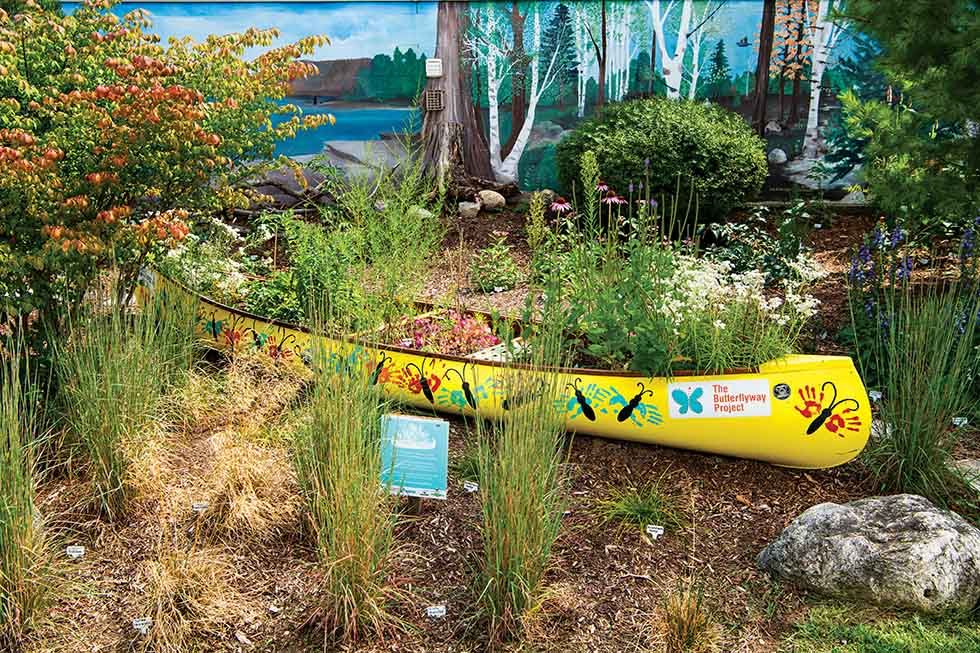
The Butterflyway Project canoe in the pollinator garden at Beaver Valley Community School.
Indeed, gardening with native plants is a powerful, personal and deeply loving way of putting one’s passion for the living world, and concern for next generations, into decisive action. Many of us are terrified observers of the world’s biodiversity crisis—as many as 1 million species of plants and animals face near-term extinction because of habitat loss. And lawn culture is a big part of that—in North America, lawn covers more area than irrigated corn fields. Also, many garden centres promote invasive cultivars that offer nothing to local animals. Ecologically, gardens can be green deserts—tidy and without life. Landscape Architect Nick Assad sees our aristocratic past: “The aesthetic of wide-open lawn with edges decorated by garden beds with showy and long-lasting flowers originated on the properties of British lords and ladies. Consciously or not, the ‘Downton Abbey’ look is deeply embedded in our culture and still defines landscape beauty.”
Native gardening signals that we take on our responsibility for the living world, and more landowners are joining this movement. Vicky Thompson has gardened in Grey/Bruce for 40 years. She always avoided pesticides and synthetic fertilizers in her gardens, yet her approach was traditional. “My goal was a beautiful perennial border—balanced for seasonal colour, interesting foliage and minimal work.” Vicky learned about the concept of ‘ecologically responsible’ gardening more recently. Over the past five or six years, she has renovated her gardens by adding native plants and habitat for native insects and birds. “My goals have changed. Aesthetically my gardens are a work in progress. Though they are not yet magazine material, they do have moments of floral balance and interest which are quite pleasing. My success is measured by the life I see and hear as I walk around the garden—the insects, the birds, the occasional amphibian.” Her gardening journey builds a connection to place: What kind of bug is eating this plant? Is it a native insect? How did it get here? What animal will prey on it? If it is a caterpillar, the likely predator is a bird feeding her young. It is commonly thought that birds feed on seeds and berries, but according to the Entomologist and Ecologist Douglas Tallamy, if you want birds successfully reproducing on your property you need native trees and shrubs to supply baby bird food in the form of nutrient- rich caterpillars. Like many other gardeners who joined the native movement, Vicky enjoys witnessing the return of biological abundance as a source of hope, meaning, and true happiness.
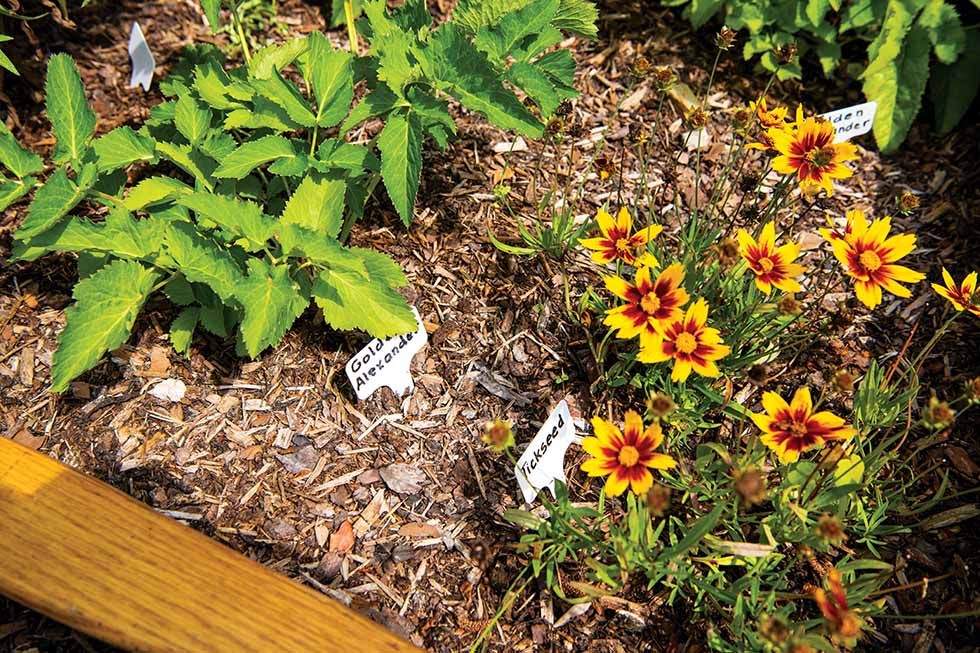
The pollinator canoe at Beaver Valley Community School.
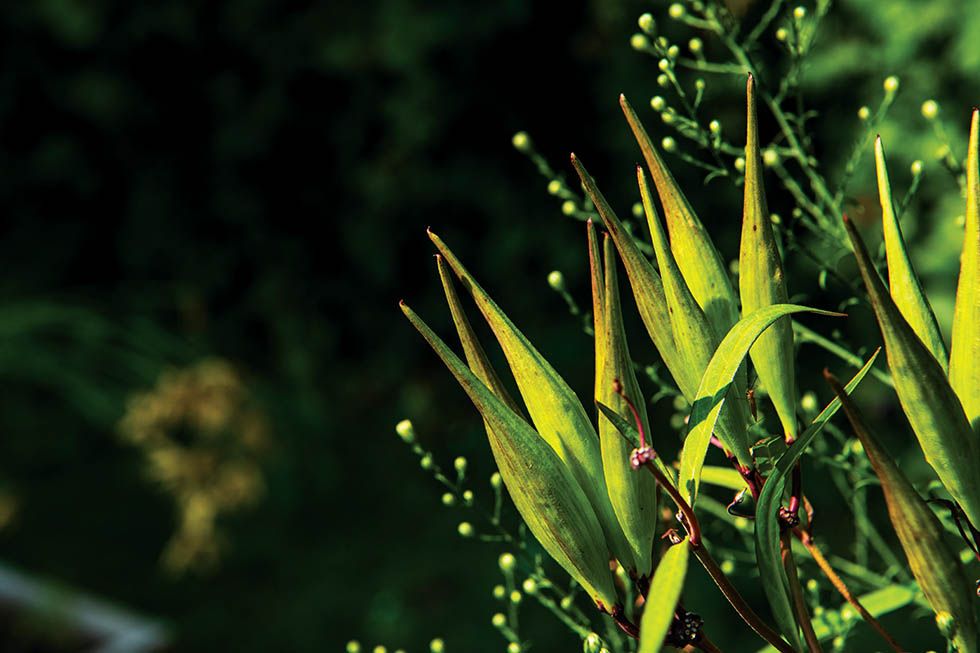
Swamp milkweed (asclepias incarnata).
Like all things cultural, the only constant is change. Landscape Architect Nick Assad sees his role as gardener or landscape designer as setting the stage for nature to unfold. Like a sprout emerging from a seed, or parents creating an enabling context for a child. Yes, beauty is an essential component because we want our homes to be beautiful, but what is beauty, really? For Nick, a native plant garden is a canvas for exploring the aesthetics of imperfection and asymmetry—a microcosm of nature for which we make space in our otherwise manufactured habitat. It starts with inspiration during a nature walk, and proceeds with rebuilding soil, arranging native materials, and placing native plants. By letting go of the pursuit of flawless beauty, the garden becomes a living tapestry of evolving forms and textures. “We’ve all heard the phrase that beauty is in the eye of the beholder, but have you ever thought of your garden from the point of view of a caterpillar or songbird? Or an owl? A frog?” When gardening with native plants, a bit of insect damage on otherwise healthy plants signals real success. Nick loves the words of Torontonian author Lorraine Johnson on what it means to garden; “No declaration is more powerful than the one that says, simply, I care for life.” (quote from book title “The Gardener’s Manifesto”).
In Bruce Grey Simcoe, many groups are emerging that specialize inion native gardening. Whether through Grey County Master Gardeners like Vicky Thompson or Ann Joyner, or through pollinator initiatives that mushroom in Owen Sound, Meaford, Blue Mountain, and Collingwood. Wiarton’s public school recently installed a Tiny Forest, another strategy to return nature into public spaces. At Beaver Valley Community School, students revitalized overgrown raised beds that are now colourful pollinator patches. With this experience, they took on something bigger: As a showcase in front of the school, students challenged themselves to design an attractive curated natural garden that engaged students, complimented the existing landscape mural on the school wall, and highlighted the existing memorial garden. A “Pollinate the Blue Mountains” canoe is a central feature of the garden placed to appear to be paddling out of the lake in the wall mural. The canoe was donated by a local family and painted by students using a playful design. Grasses were planted to wave around the canoe. A path of stepping stones was added to invite students into the garden to enjoy and learn about pollinator plants. Tree stump and driftwood elements were placed to connect the real garden to the mural shoreline. Numerous butterfly pollinator shrubs and green- stemmed flowering plants were added to fill the remaining spaces of the garden from the school door to the driveway. Parent volunteers spent countless hours together in the front garden, inadvertently building a community of care.
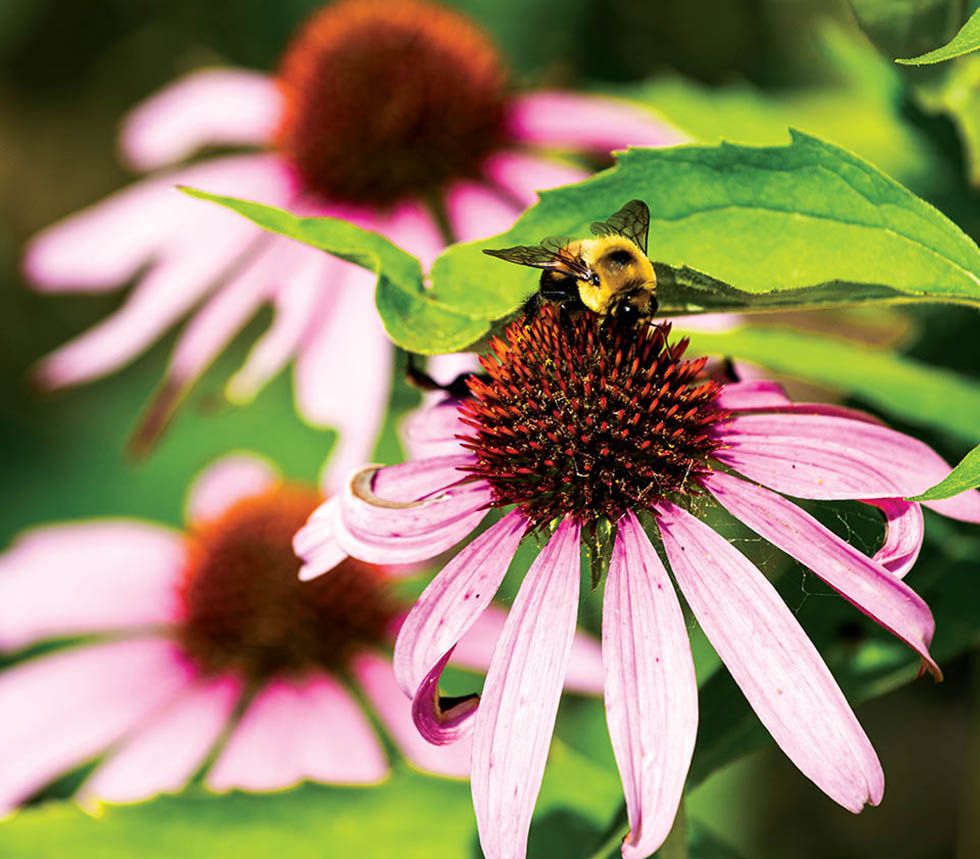
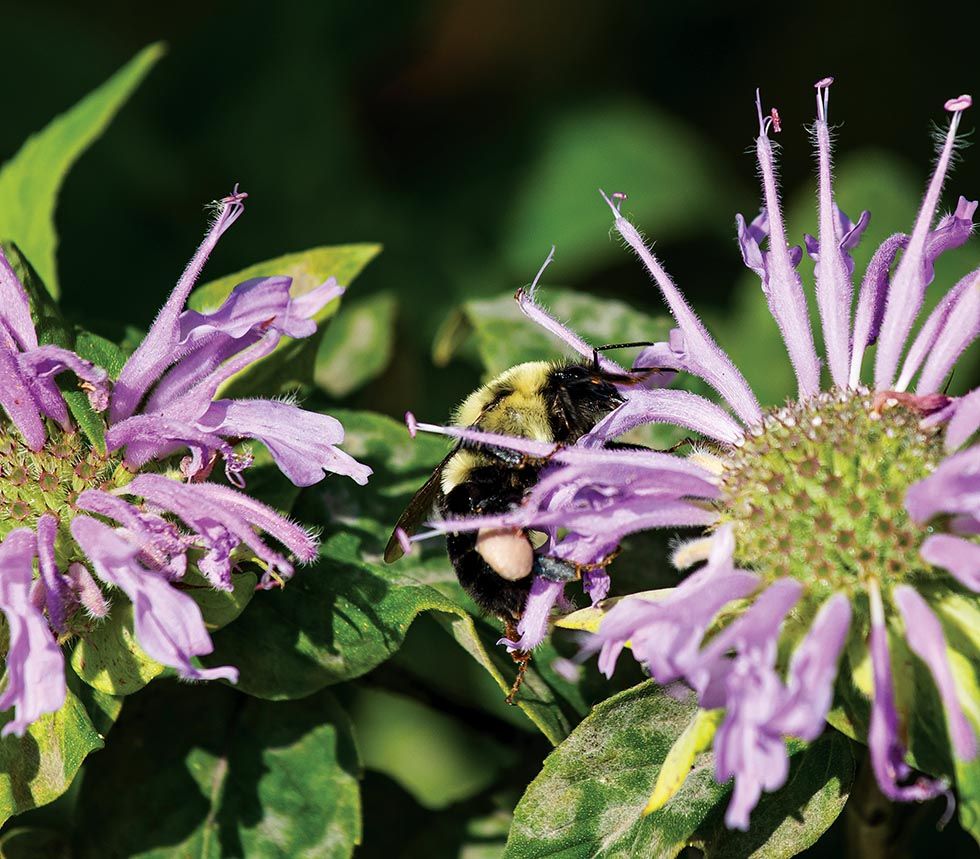
While everyone is free to collect seeds from native plants and grow them out at home, an ecosystem of skilled businesses makes the gardener’s life easier. Grey/Bruce/Simcoe is home to a number of native plant nurseries and experienced gardeners who are happy to share knowledge in talks or webinars. Others mentor and coach or offer professional workshops—check out the Grey County Master Gardeners or ask at any nursery. Landscape designers like Nick Assad, Fran Moore, or Kristie and Brenden Woods take on the challenge of gardening with native plants at all scales and budgets. Still, the native gardening movement has the excitement of novelty and allows for creating truly unique living beauty.
Province- wide, the demand for native seed and plants is increasing. Getting your hands on the plant of choice can be difficult—many specialty plants sell out early in the season. The solution lies in aligning efforts as growers, buyers, designers, land managers, and gardeners, to create an ethical, inclusive, and resilient supply chain that will support the full diversity of native plants to flourish. For example, in Meaford, Charly Baxter volunteers with the Grey Bruce Native Seed Bank initiative—a group of citizens that collects and disseminates wild plant seeds. Recently, they planted “seed orchards” for the very purpose of collecting seeds with optimal genetic diversity. The group offers bite-sized volunteering opportunities in a great? community (contact greybrucenativeseedbank@gmail.com). Other groups are complementing their skills—today, we are witnessing the birth of a new economic sector of hope. It will take our concerted effort to regenerate vibrant and biodiverse landscapes—for me, a task worth living. E
Thorsten Arnold, Persephone Market Garden (Park Head) is an educator on global change and advocate for regenerative landscape management. For more information visit ThorstenArnold.com
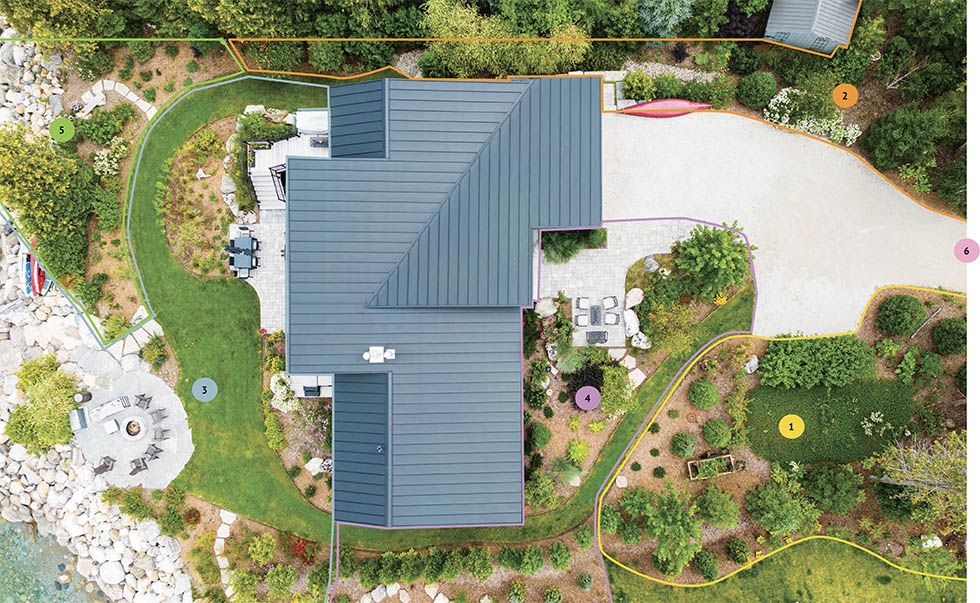
1
Food and Forest Garden
Septic bed covered in Micro-Clover and native perennials (Upland White and Yellow Goldenrods, Lanceleaf Coreopsis, Showy Tick Trefoil, Heart Shaped Aster, Green Headed Coneflower, Baneberry). Perennial food plants – Red and Black Currants, Rhubarbs, Honeyberry/Haskap, Sweet Cicely, Lovage, American Hazelnut, Red and White Gooseberry, Sorrel, Raised vegetable bed. Forest – Canadian Juniper, Spicebush, White Spruce, Slowmound Mugo Pine, White Pine, Red Osier Dogwood, Big Bluestem Grass
2
Natural Buffer
Trees – Burr Oak, Hackberry, American Hornbeam, White Birch, Eastern Redbud. Also – Mapleleaf Viburnum, Bayberry, Arrowwood Viburnum, Pearly Everlasting
3
Active Garden Space
Lawn grass interseeded with MicroClover. Herbaceous plants, shrubs and grasses – Purple Coneflower, Rough Blazing Star, Blue Hyssop, Yarrow, Pearly Everlastings, Swamp Milkweed, Rosy Pussytoes, Anise Hyssop, Grey Headed Coneflower, Foam Flower, Spirea Alba, Canadian Columbine, Culver’s Root, Wild Savory, Bluet, Tickseed, Long Leaf Coreopsis. American Elderberry, Red Osier Dogwood, Serviceberry, Common Ninebark, New Jersey Tea, Smooth Rose, Swamp Rose, Black Chokeberry, Meadowsweet Spirea. Switchgrass, Korean Reed Grass, Blue Gamma Grass, Palm Sedge, Sweet Grass, Tufted Hair Grass
4
Sheltered Entrance Garden
Driveway is permeable gravel. Trees – White Birch, Freeman Maple, Red Bud. Other herbaceous plants, shrubs and grasses – Wild Geranium, Wild Bergamot, Purple Coneflower, Munstead Lavender, Ostrich Fern, Foxglove Beardtongue, Black Eyed Susans, Blue Lobelia, Ostrich Fern, Lady Fern, Pearly Everlastings. Red Twig Dogwood, Serviceberry, Bush Honeysuckle. Prairie Dropseed Grass, Switchgrass, Blue Grama Grass
5
Contemplation Garden
Herbaceous plants – Joe Pye Weed, Common Boneset, Grey Headed Coneflower, Pink Rose Rugosa, Bearberry, Purple Coneflower, Yarrow. Shrubs – Northern Bayberry and Ninebark
6
Natural Forest (near road)
Herbaceous plants – Giant Solomon’s Seal, White Trillium, Wild Ginger, Bloodroot, Blue Cohosh, Troutlily, Lady Fern, Woodland Phlox, Hart’s Tongue Fern, Large Flowering Bellwort, Wild Columbine, Mayapple, Virginia Bluebells. Shrubs – Serviceberry, Common Strawberry, Highbush Cranberry. Trees – Spruce, Pine, Cedar


